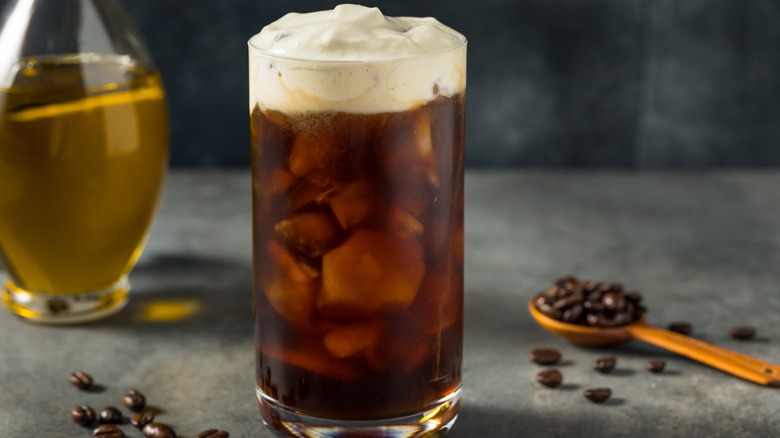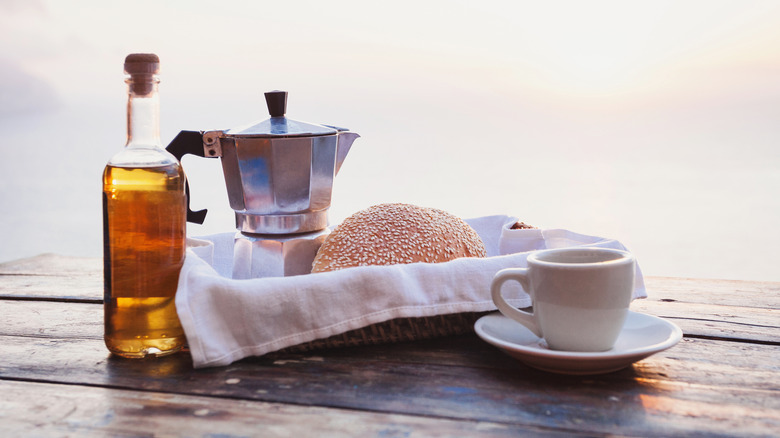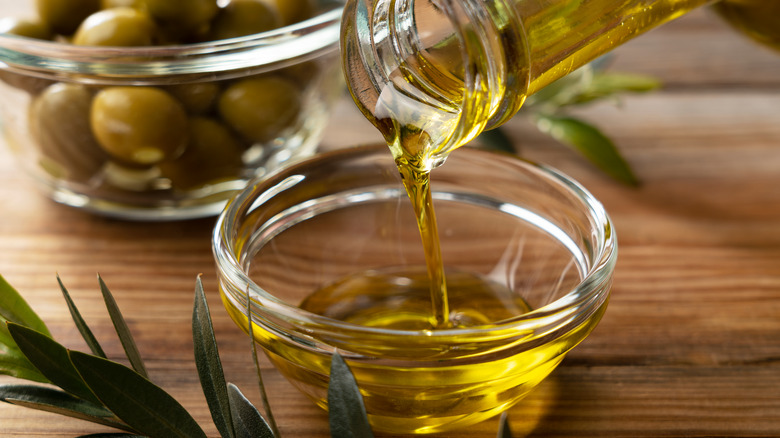How To Give Homemade Olive Oil Coffee A Personal Twist
Mixing fat and coffee is a divisive topic. While some swear by the nutritiousness of bulletproof coffee made from butter and MCT oil, the taste and texture of coffee with pools of fat floating on top are more than disappointing to others. But when Starbucks announced that it too believed in the joys of fat-based coffees with the launch of its Oleato beverages, olive oil became the thing to add for tastier cups of java — if only so that fans could see what the fuss was for themselves.
Until Starbucks' extra virgin olive oil-based lattes and cold brews make their way beyond a handful of locations in the U.S. and abroad, however, those hoping to take a sip of olive oil coffee will have to make their own brew at home. Luckily, it's not exactly rocket science, and you can give it your own twist by playing with the type of olive oil and how much you use. While Starbucks infuses the milk and cold foam for its Oleato beverages with Partanna extra virgin olive oil, making olive oil coffee at home can be as easy as whisking in a drizzle of any olive oil into any cup of Joe or steaming milk and olive oil together. From there, you can customize the coffee to your liking: The amount of olive oil that you add is entirely up to you, as is the type and the flavor that it could bring to your java.
The amount of olive oil that you add is up to you
Olive oil coffee can be made either by vigorously stirring the oil directly into hot coffee, steaming the milk and oil together before pouring it into the espresso, or whisking the oil into cold cream. The latter is an especially good idea when you're brewing iced coffees as oil and water wouldn't blend easily into one smooth mixture. But exactly how much olive oil you add is entirely up to you. A good ratio to stick by is adding one tablespoon of extra virgin olive oil for an eight-ounce cup of coffee. Once you get the hang of it, you can always lower the amount of olive oil or double it to two tablespoons depending on the taste that you develop for it.
That said, it may be wiser to stick to the more conservative side when adding any oil to coffee unless you want your java to taste more like olive oil and less like coffee. It's also worth noting that despite its many health benefits — which include improvement in heart, brain, and joint health — olive oil is high in both fat and calories (via Healthline). If you're concerned, speak to your doctor and start small. You can always add more as you go, but it's impossible to remove once it's in your mug.
Play with the flavors of different olive oils
Starbucks notes that its Oleato beverages have "uniquely nutty, slightly sweet flavors" akin to the "rich smoothness of a buttery caramel," which they get from Partanna's olive oil, but the thing about olive oil is that it can have different flavors (via Starbucks). Using high-quality olive oil goes without saying, but you can also customize your coffee by choosing an olive oil with a particular flavor.
Delicate olive oils made from more ripe olives are less pungent and bitter. Their subtle butteriness can add a creamy texture to your java without overpowering the nuanced flavors of a certain coffee bean. Medium-intensity olive oils will add fruitiness to the coffee with notes of pepper and a slight bitterness as well. On the flip side, robust olive oils are the strongest of the lot, with a certain pungency and intense peppery notes that are best left to things like salads rather than coffees.
While a delicate olive oil is thought to be better suited for coffee, it all really depends on your taste and preference. You can also pick an olive oil depending on the flavor of the beans that you're brewing: A bold medium roast, for example, may work fabulously with an herbaceous olive oil that has earthy flavors. Choose a fruity olive oil over a buttery one or even a bitter and peppery olive oil over a milder one — it's entirely up to you and the coffee beans that you're using.



